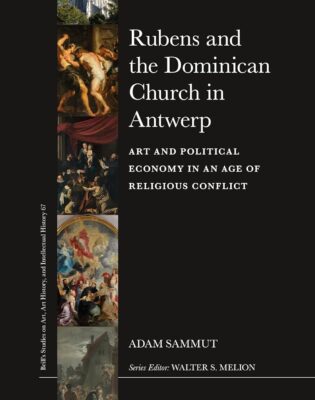This book is the revised publication of a PhD thesis, defended by the author in 2021 at the University of York. Actually, it is about two very important painting commissions for the decoration of Antwerp’s St. Paul’s church, the former church of the local Dominican monastery. The first one of these commissions is that of the series of the Mysteries of the Rosary, a set of fifteen scenes from the life of Christ, each of them destined for meditation during the recitation of the rosary prayer. This artistic project was probably initiated by Rubens c. 1617, although he executed only one of the fifteen mysteries himself, The Flagellation of Christ. However, it is striking that also Jacob Jordaens (1593-1678) as well as the young Anthony Van Dyck (1599-1641), who at that time were Rubens’s most important collaborators, each representing one of the mysteries, respectively, The Crucifixion of Christ and Christ Carrying the Cross. Moreover, Rubens engaged other of his collaborators execute parts of the series, such as the lesser known painters Artus de Bruyn (d. 1632) or Arnout Vinckenborch (c. 1590-1620). Besides these studio assistants, he was able to rely on some of the most renowned contemporary Antwerp painters whom he had befriended, like Hendrick van Balen the Elder (1574/5-1632), Frans Francken the Younger (1581-1642) or Cornelis de Vos (1584/5-1651).
The mysteries of the rosary have played an important role in the spirituality of the Dominicans. Since their origins in the thirteenth century, the principal mission of the Dominicans had always been the predication and defense of Roman Catholicism against any form of heresy. In the Netherlands, from the late sixteenth century onwards, the lasting conflict between a militant and rapidly growing Calvinism and the strict Roman Catholic dogmatism of the Spanish Habsburg rulers added an entirely new dimension to this task. In 1566 this tension erupted into the famous Calvinist iconoclasm, known as the Beeldenstorm. Thus, the Catholic restoration in the Southern Netherlands in 1585 considered the redecoration of the many damaged churches in the country one of its most important challenges in which the mystery cycle played an important role. The victory over the Turkish fleet near Lepanto in 1571 by a Roman-Catholic fleet under the command of Don Juan of Austria generally was attributed to the rosary prayer. This important event gave a new boost to the veneration of the rosary. On the Dominicans’ initiative, Catholic Confraternities of the Holy Rosary were founded everywhere in the Spanish Netherlands, including in Antwerp.
Rubens’s important role in the execution of the project of the Fifteen Mysteries of the Holy Rosary may find further support by his important contribution to the acquisition of Caravaggio’s Rosary Madonna (now in the Kunsthistorisches Museum, Vienna) for the Antwerp Dominican church around or shortly after 1619. As may be judged by A View of the Interior of the Antwerp Dominican Church by Pieter Neeffs the Elder (c. 1578 – after 1656), executed in 1636, the painting (Amsterdam, Rijksmuseum) originally was placed between two of the Fifteen Mysteries on the northern wall of the church. It thus seems that both, the series probably executed under Rubens’s supervision, and Caravaggio’s masterpiece, must soon have been considered as a unity.
Around the same time or slightly later Rubens was also commissioned to paint St. Dominic and St. Francis of Assisi Protecting the World from the Wrath of Christ for the main altar planned for the apse of the choir of the church (now Musée des Beaux-Arts, Lyon) This altarpiece clearly accentuates the important role of the mendicant orders of the Dominican and Franciscan friars, here represented by their founders, saints Dominic and Francis of Assisi, in turning away Christ’s wrath against the world, provoked by heresy, represented by a snake circling around the world globe. At the time of the delivery of the painting the church still was missing a complete choir. Thus, the painting only received its definite place in the church after the completion of the choir in 1639. There it could be seen in harmony with the stained glass windows executed from1633 onward by another important Rubens epigone, Abraham van Diepenbeeck (1596-1675) in a style clearly and strongly indebted to Rubens’s contemporary dramatic high baroque style. These windows have been lost since the early nineteenth century but can still partially be judged thanks to a number of still existing modelli. The windows contained a series of scenes from the life of St. Paul, with whom the Dominican order, and certainly Michael Ophovius (1571-1637), then bishop of ’s-Hertogenbosch, but formerly prior of the Antwerp convent and buried in the choir of St. Paul’s church, must have felt congenial in their role as defenders of the True Faith.
These are, in a nutshell, the main points of Sammut’s book. The greatest merit of this comprehensive monograph is the fact that for the first time the many data related to the history and decoration of Antwerp’s St. Paul’s church have been listed and interpreted as accessibly as possible. This seems to be the best starting point for further research. Preferably this might also include an in-depth investigation of Rubens’s altarpiece of The Real Presence in the Holy Sacrament, another major work painted by him for St. Paul’s church, in the context of the Dominicans’ importance in Counter-Reformation Antwerp.
Hans Vlieghe
Centrum Rubenianum, Antwerp
